Information for Practitioners
Dressing information
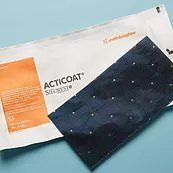
Acticoat
What is it?
An absorbent rayon/polyester inner core sandwiched between outer layers of silver-coated, low adherent polyethylene net.
What does it do?
The silver in the dressing protects the wound site from bacterial contamination.
In the presence of exudate, the inner core helps maintain a moist wound environment.
Where is it used?
Can be used on epidermal/dermal burns with a layer of solosite.
How is it used?
- Cut Acticoat to size of raw area with clean scissors.
- Wet Acticoat in water to moisten.
- Spread solosite onto blue side of dressing if required
- Place Acticoat blue side down on raw area. (Other side is silver in colour.)
- Cover Acticoat areas with hyperfix.
- You can shower and lightly wet the affected areas, then pat dry.
- MUST BE KEPT MOIST BY PATIENT WITH WATER
- Acticoat is changed every 3 days.
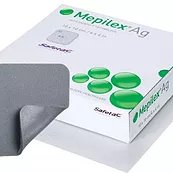
Mepilex Ag
What is it?
Antimicrobial foam dressing
What does it do?
Mepilex Ag inactivates wound related pathogens.
Soft, conformable foam which absorbs exudate.
Where is it used?
Recommended for epidermal/dermal burns that have had clean first aid.
How is it used?
- Foam cut to cover burn area and approximately 2cm around wound, so that it adheres.
- Secure foam with hyperfix or cohesive bandage.
- Foam must be in contact with wound at all times, or is ineffective.
- Dressing changed every 3 days.
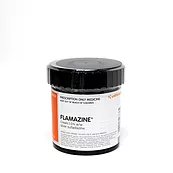
Flamazine
What is it?
Silver sulphadiazine cream
What does it do?
This is the only product, which penetrates eschar.
Anti-bacterial cover.
Cream stops wound drying out.
Where is it used?
Can be applied to burn areas all over the body, except to the face.
How is it used?
- Apply 2-3 mm of cream onto burned area.
- Smear cream on, no need to rub it in.
- Ensure all broken areas are covered, as well as all blisters.
- Cover cream with melolin and secure with bandage.
- Change dressing daily.
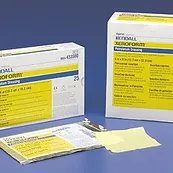
Xeroform
What is it?
Fine mesh absorbent gauze, impregnated with Bismuth Tribromophenate in a petroleum blend.
What does it do?
Antiseptic cover to raw areas.
Used in conjunction with soft white paraffin to keep wound moist.
Where is it used?
Used on epidermal/dermal burns.
How is it used?
- Cut Xeroform to size of affected area.
- Smear generous amount of soft white paraffin onto dressing and place on wound.
- Cover with melolin and bandage.
- Xeroform dressings are changed every 2 – 3 days.
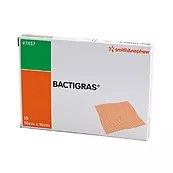
Bactigras
What is it?
Leno weave gauze impregnated with white paraffin containing 0.5% chlorhexidine acetate B.P.
What does it do?
Chlorhexidine acetate antiseptic is slowly released, giving long lasting action against gram +ve and gram –ve bacteria.
Where is it used?
Bactigras is applied to new grafts in theatre and left intact for 5 days.
Can be used on dermal burns in conjunction with flamazine so as to help lift the eschar/pseudo membrane.
How is it used?
- Cut Bactigras to size of wound with clean scissors.
- Place Bactigras on wound.
- Smear flamazine over the top of the Bactigras.
- Cover with melolin and heavy crepe bandage.
- Bactigras and flamazine are changed daily.
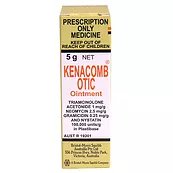
Kenacomb
What is it?
Is an ointment containing a combination of the following medicines:
- triamcinolone acetonide, belongs to a class of drugs called corticosteroids, which helps to relieve itching, inflammation and redness.
- neomycin, is an antibacterial medicine.
- gramicidin, is an antibacterial medicine.
- nystatin, is an antifungal drug. It is used to prevent or treat a particular type of fungal infection called Candida albicans.
Where is it used?
Use on wounds with hypergranulated tissue.
Use on wounds that are inflamed.
How is it used?
- Smear ointment onto a layer of xeroform or bactigras and place on the hypergranulated or inflamed wound.
- Cover with dressing e.g. melolin and secure.
- Dressing should be changed daily to monitor progress of wound.
- Ointment should only be used for maximum of 5 days at times.
- When hypergranulation / inflammation settle, dressings should revert back to soft white paraffin with xeroform / bactigras.
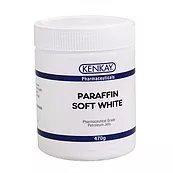
Soft white paraffin
What is it?
White soft paraffin is also known as white petroleum jelly.
This is not an active ingredient as such, but works as a moisturiser by providing a layer of oil on the surface of the skin to prevent water evaporating from the skin surface. It is a very greasy moisturiser.
Where is it used?
Epidermal and dermal burns with xeroform or bactigras to keep moist wound bed.
How is it used?
- Smear thick layer of soft white paraffin onto xeroform or bactigras and apply to wound.
- Cover with dressings and secure.
- Dressing can then be left on for 2 days.
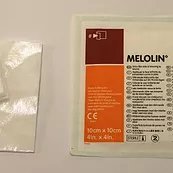
Melolin
What is it?
Low adherent and absorbent dressing.
How to use it?
- Cut melolin to size of wound that requires covering.
- Cut slits into edges of melolin when covering arms and legs, wrap around area
- Tape melolin together and secure with bandage.
- If only chest piece needed, keep in place with fastanet.
- If tape on the skin is required, hyperfix should be used.
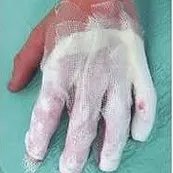
Suprathel
What is it?
Is a purely synthetic dressing that is biocompatible and absorbable. Main constituent is polylactic acid.
What does it do?
It covers the wound like a second skin and promotes healing and reduces pain. Suprathel was developed analogous to the human skin and thus shares the same properties such as elasticity, permeability to water vapour and impermeability to bacteria.
Where is it used?
Applied once in the operating theatre onto a cleaned and disinfected wound – usually donor sites but can be debrided dermal burns.
How is it used?
After the application, the Suprathel becomes transparent. It should be then covered with 1 – 2 layers of paraffin gauze and left on the wound until it is fully healed. The dressing can be then covered with an absorbent dressing and secured. The dressing is then left intact for 10 days or until the wound is healed. As the wound heals suprathel will peel off and can be trimmed. The outer dressings can then be removed and soft white paraffin applied directly to the paraffin gauze second daily. DO NOT pull gauze dressing off. DO NOT wet dressings, as it will slide off wound.
Burns physiotherapy
When to refer to Physiotherapist after burns treatment?
Burns to Hands
Physiotherapy aims to achieve full hand range of motion, minimise oedema and ensure use of hand in daily function from Day 1 post injury. Fingers should be bandaged individually to ensure the patient can regularly practice finger movement and use hand functionally.
Burns that cross any joint (including neck / face)
Physiotherapy aims to achieve full range of movement of the affected joints and prevent contracture development
Burns to lower limbs especially when over foot
Physiotherapy aims to ensure the patient is mobilising full weight bearing with appropriate gait pattern from Day 1 post injury. It is important to avoid crutches where able as the patient will have a better outcome if they are able to walk with a normal gait pattern from Day 1 of their injury. To allow this mobility appropriate lower limb compression may be required and appropriate footwear prescribed eg sheepskin lined postop shoes for burns to soles of feet.
Suspected Inhalation injury
Physiotherapy aims to assist the patient with breathing exercises that improve air entry and secretion removal.
Further information
If you require any further information regarding Physiotherapy after Burn Injuries please contact Anita Plaza, Team Leader Physiotherapist via:
- Phone: (07) 3646 8111
- Pager: 42433
- Email: anita.plaza@health.qld.gov.au
Physiotherapy exercise handouts
Contact us
Burns Outpatient Clinic
Location: Level 1 Dr James Mayne Building
Phone: (07) 3497 3588
Professor Stuart Pegg Adult Burns Unit (Ward 4C)
Location: Level 4 Dr James Mayne Building
Phone: (07) 3646 3273
Need help outside hours?
For non-urgent medical issues call 13 HEALTH (13 43 25 84) or visit your GP.
In an emergency call 000.
Refer a patient
To refer your patient, view the Burns referral guideline.
Emergency patient transfer form
GP and Specialist Referral Hotline: 1300 364 938
